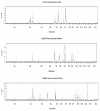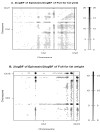Mapping main, epistatic and sex-specific QTL for body composition in a chicken population divergently selected for low or high growth rate
- PMID: 20149241
- PMCID: PMC2830984
- DOI: 10.1186/1471-2164-11-107
Mapping main, epistatic and sex-specific QTL for body composition in a chicken population divergently selected for low or high growth rate
Abstract
Background: Delineating the genetic basis of body composition is important to agriculture and medicine. In addition, the incorporation of gene-gene interactions in the statistical model provides further insight into the genetic factors that underlie body composition traits. We used Bayesian model selection to comprehensively map main, epistatic and sex-specific QTL in an F2 reciprocal intercross between two chicken lines divergently selected for high or low growth rate.
Results: We identified 17 QTL with main effects across 13 chromosomes and several sex-specific and sex-antagonistic QTL for breast meat yield, thigh + drumstick yield and abdominal fatness. Different sets of QTL were found for both breast muscles [Pectoralis (P) major and P. minor], which suggests that they could be controlled by different regulatory mechanisms. Significant interactions of QTL by sex allowed detection of sex-specific and sex-antagonistic QTL for body composition and abdominal fat. We found several female-specific P. major QTL and sex-antagonistic P. minor and abdominal fatness QTL. Also, several QTL on different chromosomes interact with each other to affect body composition and abdominal fatness.
Conclusions: The detection of main effects, epistasis and sex-dimorphic QTL suggest complex genetic regulation of somatic growth. An understanding of such regulatory mechanisms is key to mapping specific genes that underlie QTL controlling somatic growth in an avian model.
Figures


Similar articles
-
Genome-wide interval mapping using SNPs identifies new QTL for growth, body composition and several physiological variables in an F2 intercross between fat and lean chicken lines.Genet Sel Evol. 2013 Sep 30;45(1):36. doi: 10.1186/1297-9686-45-36. Genet Sel Evol. 2013. PMID: 24079476 Free PMC article.
-
Genetic analysis of an F(2) intercross between two chicken lines divergently selected for body-weight.BMC Genomics. 2009 May 27;10:248. doi: 10.1186/1471-2164-10-248. BMC Genomics. 2009. PMID: 19473501 Free PMC article.
-
QTL for several metabolic traits map to loci controlling growth and body composition in an F2 intercross between high- and low-growth chicken lines.Physiol Genomics. 2009 Aug 7;38(3):241-9. doi: 10.1152/physiolgenomics.90384.2008. Epub 2009 Jun 16. Physiol Genomics. 2009. PMID: 19531576
-
Chicken lines divergent for low or high abdominal fat deposition: a relevant model to study the regulation of energy metabolism.Animal. 2013 Jun;7(6):965-73. doi: 10.1017/S1751731113000153. Epub 2013 Feb 22. Animal. 2013. PMID: 23433003 Review.
-
Mapping quantitative trait loci and identification of genes that control fatness in poultry.Proc Nutr Soc. 2002 Nov;61(4):441-6. doi: 10.1079/pns2002185. Proc Nutr Soc. 2002. PMID: 12691173 Review.
Cited by
-
QTL Fine Mapping for Sex Determination Region in Bighead Carp (Hypophthalmichthys nobilis) and Comparison with Silver Carp (Hypophthalmichthys molitrix).Mar Biotechnol (NY). 2020 Feb;22(1):41-53. doi: 10.1007/s10126-019-09929-3. Epub 2019 Nov 27. Mar Biotechnol (NY). 2020. PMID: 31776800
-
Association of the thyroid hormone responsive spot 14 alpha gene with growth-related traits in Korean native chicken.Asian-Australas J Anim Sci. 2020 Nov;33(11):1755-1762. doi: 10.5713/ajas.19.0541. Epub 2020 Feb 25. Asian-Australas J Anim Sci. 2020. PMID: 32106653 Free PMC article.
-
A genome scan revealed significant associations of growth traits with a major QTL and GHR2 in tilapia.Sci Rep. 2014 Dec 1;4:7256. doi: 10.1038/srep07256. Sci Rep. 2014. PMID: 25435025 Free PMC article.
-
Genome-Wide Linkage Analysis Identifies Loci for Physical Appearance Traits in Chickens.G3 (Bethesda). 2015 Aug 6;5(10):2037-41. doi: 10.1534/g3.115.020883. G3 (Bethesda). 2015. PMID: 26248982 Free PMC article.
-
Genome-Wide Association Study for Muscle Fat Content and Abdominal Fat Traits in Common Carp (Cyprinus carpio).PLoS One. 2016 Dec 28;11(12):e0169127. doi: 10.1371/journal.pone.0169127. eCollection 2016. PLoS One. 2016. PMID: 28030623 Free PMC article.
References
-
- Arthur JA, Albers GAA. In: Poultry Genetics, Breeding and Biotechnology. Muir WH, Aggrey SE, editor. UK: CABI Publishing; 2003. Industrial perspective on problems and issues associated with Poultry Breeding; pp. 1–12. full_text.
-
- Eisen EJ. Selection experiments for body composition in mice and rats: A review. Livest Prod Sci. 1989;23:17–32. doi: 10.1016/0301-6226(89)90003-1. - DOI
-
- Jennen DGJ, Vereijken ALT, Bovenhuis H, Crooijmans RPMA, Veenendaal A, Poel JJ van der, Groenen MAM. Detection and Localization of Quantitative Trait Loci Affecting Fatness in Broilers. Poult Sci. 2004;83:295–301. - PubMed
Publication types
MeSH terms
Grants and funding
LinkOut - more resources
Full Text Sources
Miscellaneous

